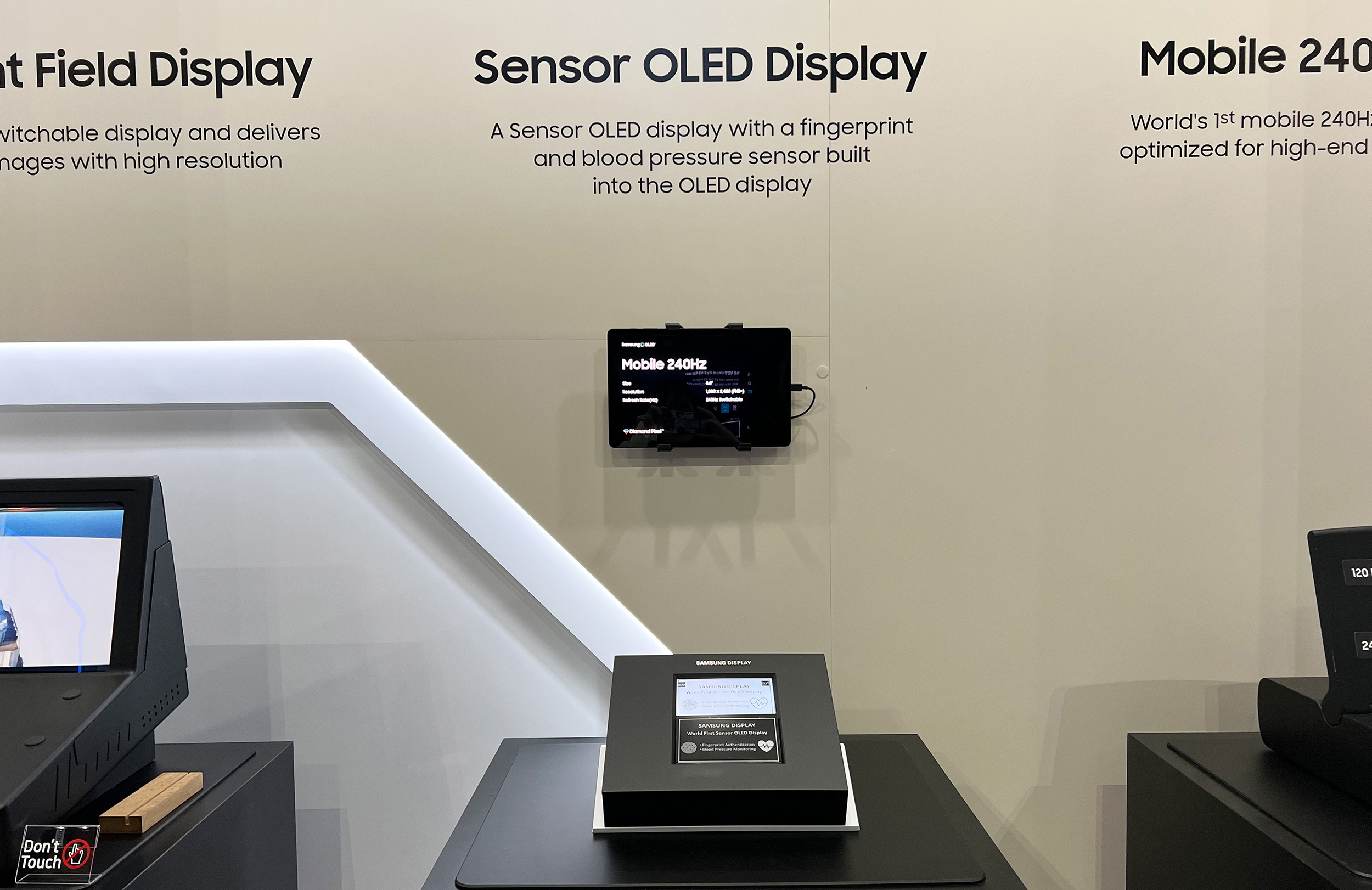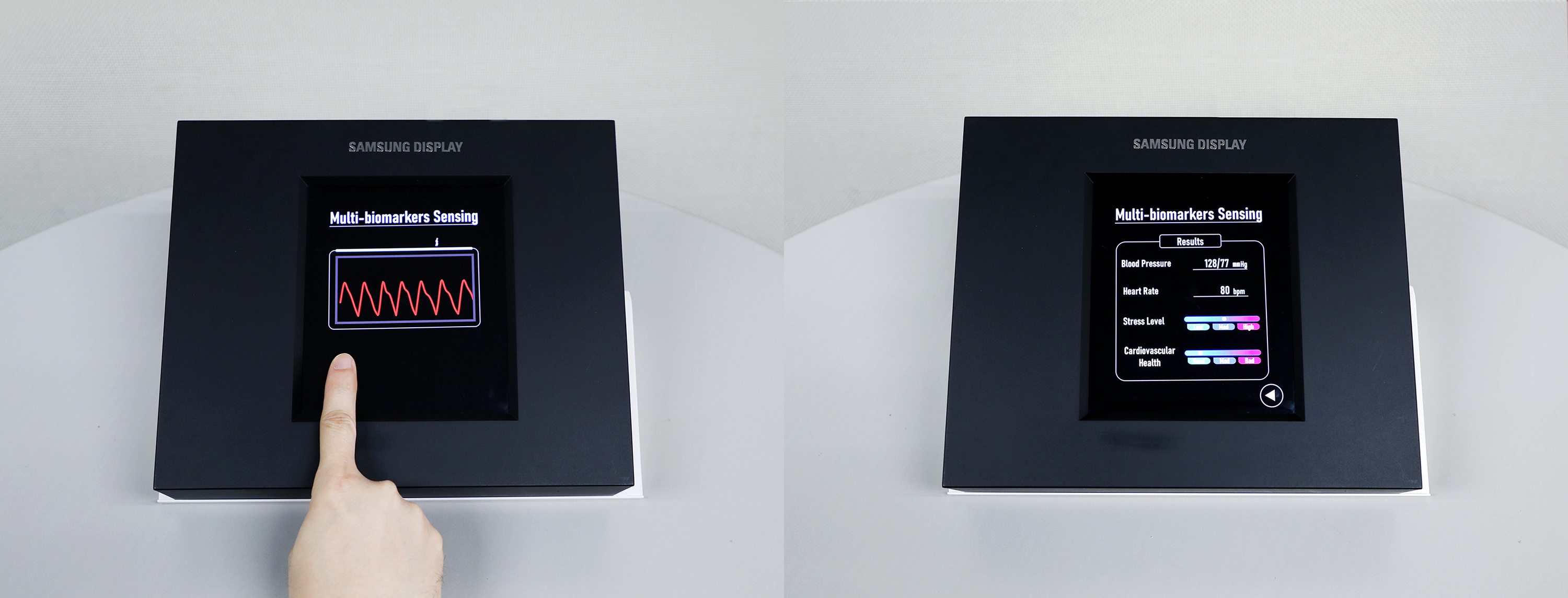05.23.2023
Samsung Display has unveiled a new generation of OLED panel that it says can recognize fingerprints anywhere on the screen and even check the user's heart rate, blood pressure, and

Samsung's 'Sensor OLED Display' at SID Display Week 2023
Usually, fingerprint sensors in smartphones are attached under the display panel as a separate module and are only sensitive to fingerprint data within a limited portion of the screen. By contrast, Samsung's new "Sensor OLED Display" extends this sensitivity to the entire screen by embedding a light-sensing organic photodiode (OPD) into the panel itself.
The technology currently being shown off at SID Display Week 2023 opens up some exciting possibilities for future smartphones, such as multi-finger authentication (putting four fingers on the display, for example), which could offer several thousand million times stronger security than a single finger.
Another potential feature could be the ability to authenticate individual apps on a phone's Home Screen simply by placing a finger on the app icon to open it, replacing the need for a passcode or facial authentication.
But perhaps the most intriguing claim being made is the ability of the Sensor OLED Display to check cardiovascular health, including blood pressure when two fingers are used.
"To accurately measure a person's blood pressure, it is necessary to measure the blood pressure of both arms," notes Samsung Display's press release. "The Sensor OLED display can simultaneously sense the fingers of both hands, providing more accurate health information than existing wearable devices."
Samsung says the system works because OLED light is reflected differently depending on the contraction and relaxation of the blood vessels inside the finger, and when it returns to the panel, the OPD is able to recognize it and converts it into a blood pressure reading.

'Sensor OLED Display' measuring blood pressure and heart rate
Samsung did not provide information on the accuracy rate or speed of its Sensor OLED display, nor did it explain whether the authentication and biometric readings could be taken at the same time, but the company clearly has confidence that the technology is destined for smartphones in the near future.
Could it or something similar one day appear in an iPhone? It's no secret that Apple has been working on a Touch ID system designed to be set under the display since at least 2013, with several patents awarded to the company over the years. Indeed, despite claims that under-screen Touch ID on a future iPhone is unlikely, Apple has, if anything, intensified its research in under-screen fingerprint sensing technology.
Earlier this year, Apple was granted a patent relating to under-screen Touch ID that combines shortwave infrared technology with an optical imaging system that could have multiple functions. Not only does the latest embodiment aim to read the user's fingerprint when it touches the display, it could also determine vein pattern, blood oxygenation, pulse, and the presence of gloves and wetness.
At this point, we can't be certain that Apple will ever put Touch ID under iPhone screens. There also remains a possibility that Apple instead introduces an iPhone with Touch ID built into a physical side button, in line with the latest iPad Air and iPad mini models, although there haven't been any rumors to suggest that Apple plans to follow that route.
Apple's roadmap for under-panel technology, as outlined by DSCC industry consultant Ross Young, suggests we're unlikely to see an under-screen version of Touch ID in an iPhone anytime soon. Apple appears to be more focused on moving Face ID and the front-facing camera under the display, both of which it aims to achieve by 2027.
Tag: Samsung
This article, "Samsung Unveils World's First OLED Display With Built-In Fingerprint and Blood Pressure Sensing" first appeared on MacRumors.com
Discuss this article in our forums
You may also be interested in this
Apple and Disney partner …
06.05.2023
Disney CEO Bob Iger made a surprise appearance during the WWDC keynote to announce that the Disney+ app will launch on Apple Vision Pro with 3D interactive experiences from "Star
Apple provides official d…
06.07.2023
Developers that rely on Figma for design collaboration now have access to official Apple Design Resources, with more to come.Apple Design Resources on FigmaFigma is a popular design tool built
A new web standard will a…
06.15.2023
The World Wide Web Consortium is working to further secure online payments in browsers with a new technology that works alongside other payment services like Apple Pay, Google Pay, and
Why iPhone prices probabl…
04.10.2025
Find out how the iPhone price may be affected by new Trump tariffs and Apple's stockpiling tactics before the trade war began. (via Cult of Mac - Apple news, rumors,
Why the ‘iPhone SE Plus’ …
10.21.2024
Macworld Just when we thought we’d got a handle on next spring’s iPhone SE 4 launch, a hugely surprising leak comes along and throws everything into doubt. The 4th-gen SE
Using the Apple Vision Pr…
06.09.2023
CNN Business’ Samantha Murphy Kelly experienced Apple’s Vision Pro hands on demo this week and feels she’s “seen the future.” Apple Vision Pro features an ultra-high-resolution display system that packs
How to get Apple TV &…
01.09.2023
You should bring creature comforts if you're stuck in a hotel for a long period of time. Here's how to get going with an Apple TV, HomePod, or both while
An air of doubt surrounds…
05.18.2023
At WWDC 2023, on June 5th, Apple will attempt to do for mixed-reality headsets what it’s previously done for personal computers, portable media players, tablets, smartwatches, and smartphones. No everyone


